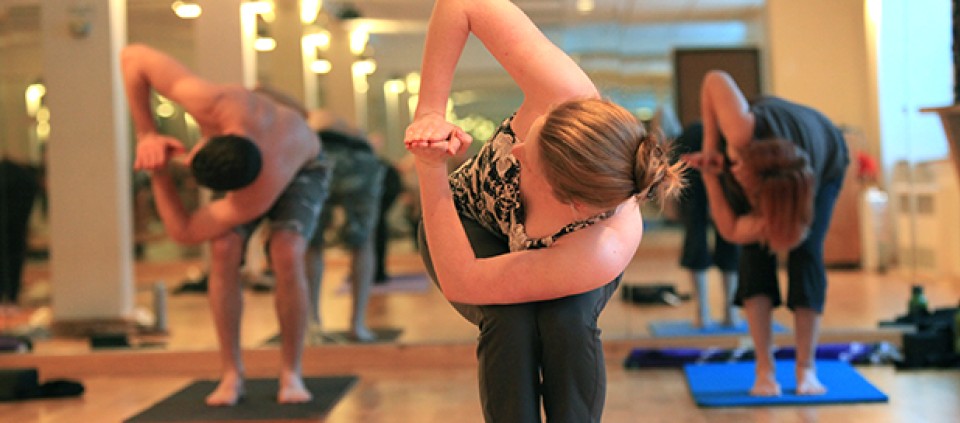Six Keys to Staying Centered in a Vigorous Yoga Class

Even when you feel ready to go deeper in your yoga practice, classes that are labeled “advanced,” “Level 3,” or “vigorous” can feel intimidating. So how can you play your edge and also stay safe in your body when you find yourself in a more challenging practice? Here are six ways to stay centered when the heat is on.
- Remember the roots of the posture. Each posture is typically an evolution of another posture—for example, Knee-Down Lunge progresses to Crescent Lunge, which evolves into Warrior III. You can always choose to take a less complex version, while still staying engaged and present, and you’ll still receive many of the benefits of the pose.
- Use posture options. Think about how the posture feels, not about whether it looks picture-perfect. Contemplate the primary action in each pose and adjust your body to create the greatest comfort based on this information. For example, in Chair pose, teachers often instruct us to align our biceps with our ears. But, depending on your bone structure, this can put excess strain on the upper shoulders. Chair pose can be a vigorous posture even when your hands are resting on your waistline or extending straight out in front of the torso.
- Expand your definition of “advanced.” Some advanced classes focus on postures that make most of us shake our heads and laugh—twisting pretzels and one-armed balances. You’ll know you’ve found a skilled teacher when he or she takes you to the next level with an exploration of attention, endurance, flexibility, and strength. In a skillfully delivered class, you can choose the lower-intensity posture options every time, and still have a deep, powerful experience that touches body and spirit.
- Use props. Some people think that using yoga props (blocks, straps, etc.) means you are less advanced. Not true. As you build awareness of your body and the biomechanics of each posture, you begin to know exactly where and when you need props. After 14 years of practice, I still use two blocks in lunges to take pressure off my hamstrings. Remember, suffering is optional!
- Take a break. When we try something new, we can get attached to needing to be perfect right away. In exploring a more heated practice, remember to manage your energy levels so you feel refueled, not drained, at the end of class. There’s no shame in skipping a vinyasa transition. You are allowed to pause in Downward-Facing Dog and reclaim your breath, and it’s even legal to rest in Child’s pose! Each time you show up to your practice, your body is different. The mark of an experienced practitioner is the ability to listen within and adjust, based not on what the teacher is offering, but on what you’re experiencing.
- Lighten up. In yoga, attitude is one of the key ingredients for shifting your experience. Instead of being so serious about a vigorous class, give yourself permission to fall, make mistakes, smile, even laugh. Remember—it’s a practice! Take your time and honor the process of learning.
Try these strategies, and you might find you enjoy your vigorous practice even more as you get inspired by others, celebrate the simplicity of moving fluidly with the breath, and receive the benefits of sweating and detoxifying. A vigorous practice can be a wonderful sandbox of exploration for learning and creativity, as you hone mindfulness, build endurance, and enhance your inner vitality.
© Kripalu Center for Yoga & Health. All rights reserved. To request permission to reprint, please e-mail editor@kripalu.org.
Danny Arguetty, MA, E-RYT 500, is the mindfulness program manager at the University of Washington, a yoga teacher trainer, nutrition and life coach, health counselor, and wellness educator.
Full Bio and Programs